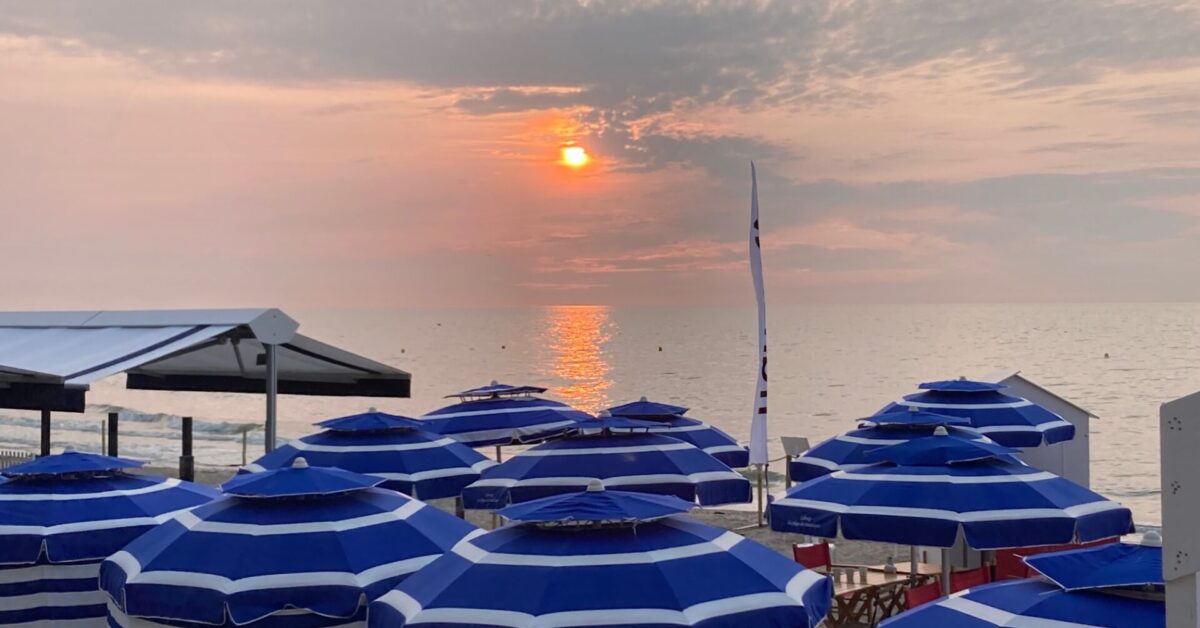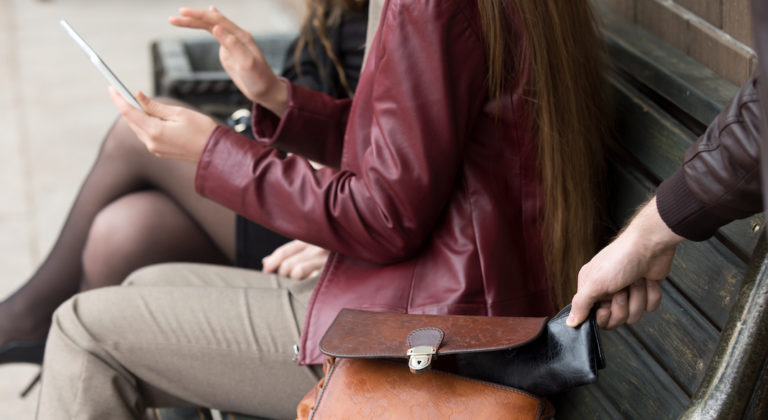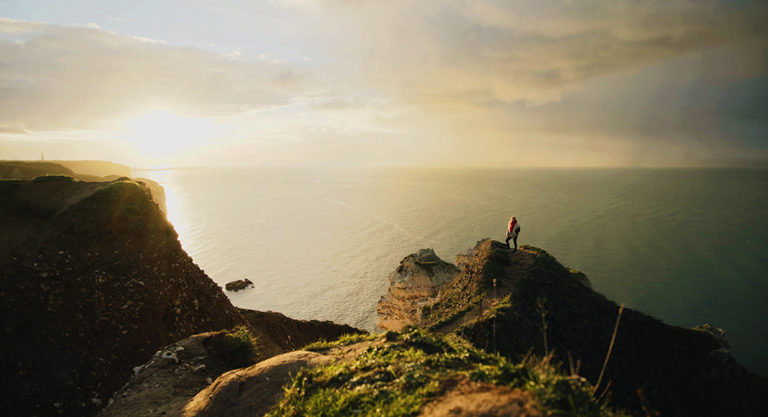Normandy in Northwestern France is a region overflowing with culture and history. It’s home to the D-Day landing beaches, as well as of William the Conqueror, the ruler of Normandy who became King of England in 1066 after winning the battle of Hastings. Normandy is also known and loved by the French for its abundance of charming French villages, half-timbered architecture, horse farms, cathedrals, castles, gardens, bike trails, outdoor activities, sandy beaches, and of course exquisite local food and drink.
Two years ago, my cousin Sarah (who has the best advice on just about everything) introduced us to the wonders of Northern France when she invited us to visit her and her companion Maurice on a day trip from Paris to the beach town of Cabourg (made famous as the model for the fictional town of Balbec in Proust‘s Remembrance of Things Past). Ever since that day, Normandy has been our top go-to getaway region.
Starting at just over two hours by train or car from Paris, the region is a perfect choice for a short getaway or extended road trip (or two). Here are a few of our favorite places in Normandy to escape to.
Table of contents:
- Where is Normandy?
- Getting To Normandy from Paris by Train
- Tips for Traveling From Paris to Normandy
- Paris to Normandy by Car: the Best Road Trip Route
- Getting to Caen by Train, and Around Normandy by Car
- The Best Places to Visit in Normandy
- Cabourg
- Honfleur
- Bayeux
- The Cheese route
- Frequently Asked Questions
Where is Normandy?
The Normandy region is located in Northwestern France, and is known for sites crucial to French history, like Mont-Saint Michel, various WWII memorials, and sites related to the Norman conquest. Its distance from Paris means that it makes sense to stay overnight, but you’ll be rewarded with fewer tourists than in major French cities, adorable towns where everything is within walking distance, and the opportunity to speak French over a hearty lunch of galettes and cider.
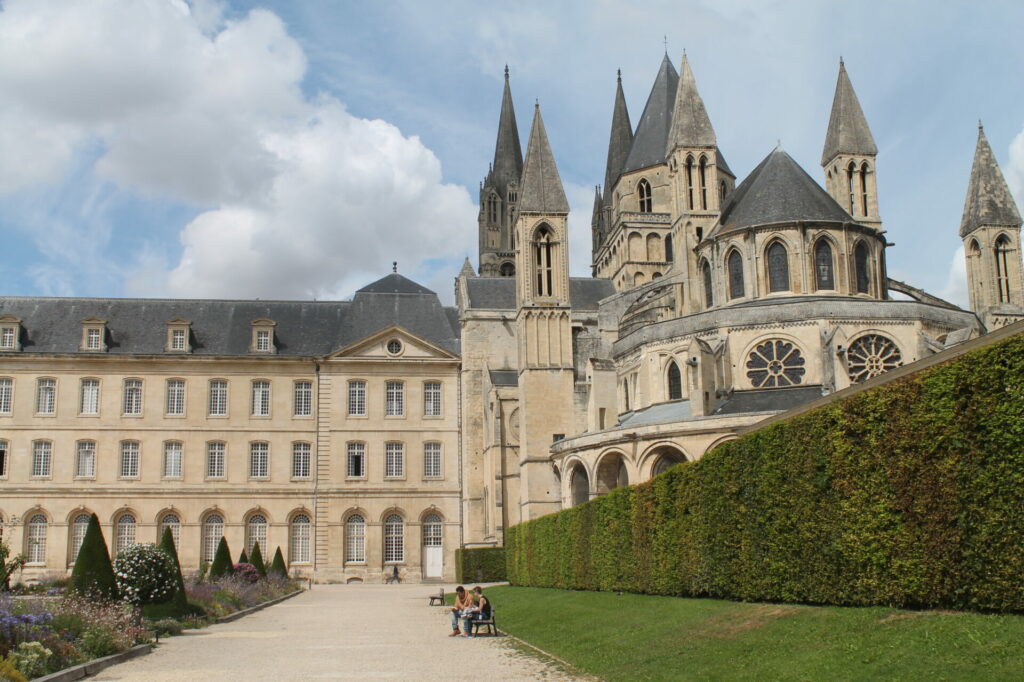
Getting To Normandy from Paris by Train
The national train company, the SNCF, has a train line dedicated to the Normandy region called the Nomad, with almost all departures from Gare Saint Lazare in Paris, an easily accessible train station in the 8eme arrondissement. This is the easiest way to get from Paris to Normandy without a car. It has a terrific shopping arcade with a number of great places to eat, and terrific takeaway for a picnic on your train trip. Notable train station food spots include: Ladurée (famous macarons), Brasserie Lazare (from Michelin starred chef Eric Frechon), Dalloyau (amazing pastries), and Paul (reliable baked goods).
The city of Caen is two hours and twenty minutes direct from Paris, making it an ideal launch point for a getaway from Paris to Normandy. (The Caen train station is also the terminal for Normandy’s reliable Nomad bus system which services a good number of cities, villages and beach towns.) Train ticket prices vary widely based on season and time of day, averaging approximately €18-50 round-trip. (To visit the D-day landing beaches you’d probably want to take the train to Cherbourg, Normandy, but we’ll cover that in a separate piece, along with suggestions for day tours of WWII memorials, the Normandy American cemetery, Juno Beach, and the Pointe du Hoc.) Rouen is another big city in Normandy that is a direct train ride from Paris, but I’ve kept to places I’ve been and vetted for my recommendations here.
Tips for traveling from Paris to Normandy
The SNCF Connect app is very user-friendly, and I find it easier to use than their website.
If you modify your selection, or begin a new search, there’s a good chance your old choice is still in your check-out basket (it’s not that clear), so be sure to review at check out and manually delete your first selection or you’ll be charged twice! (It’s happened to the best of us.)
I strongly recommend spending the extra four or five Euros for a “flexible” ticket from Paris to Normandy, which you can easily exchange or cancel up until your departure.
It’s quite challenging to find customer service phone numbers in France where you can speak to real people, but I’ve found two invaluable ones to share: for SNCF in English, 01 84 94 36 35, and to deal with issues such as refunds, cancellations and changes, 01 84 91 91 91. (From the U.S. dial 001 + 33 + the number, omitting the 0. So it would look like 001 33 01 84 91 91 91.)

Paris to Normandy by Car: the Best Road Trip Route
If you love driving and aren’t concerned with the sticker shock of renting a car in France, gas, and toll prices (it cost us over €50 for gas and tolls to Caen), renting a car can offer you the opportunity to get off the beaten path and not be tied to train and bus schedules. Paris to Caen is about two hours forty minutes on the A13 highway. I find that Avis is reliable and flexible for car rentals in Paris (though you can check out our full guide to renting a car in France here). Since they’re closed on Sundays, they always let us return the car on Monday morning at no extra charge.
Getting to Caen by Train, and Around Normandy by Car
If you want to avoid the possible traffic and daunting web of roads leaving Paris, you could take the train to Normandy and rent a car in Caen to continue your sojourn by car from there. You could also save about €45 (with Avis) thanks to often favorable prices outside Paris.

The best places to visit in Normandy
Caen
During World War II, the bombing campaign by the Allied troops to dislodge the entrenched German army resulted in the destruction of much of the city, as well as two thousand civilian casualties. Luckily, a good deal of this Medieval city’s key historical sites survived. You might begin your visit with the very helpful folks at the tourist office. We spent the lion’s share of our time in the sizable old-quarter of the city, called le Quartier Vaugueux (‘voh-guh’), a maze of narrow flagstone streets and stone and half-timbered houses, charming bistros and contemporary boutiques.
What to do and see in Caen
William the Conqueror, the most important historical figure associated with the city, is buried at the stunning Abbaye aux Hommes (Men’s Abbey), considered a forerunner of Gothic style cathedrals, with an impressive nine towers and spires. William commissioned the abbey, as well as the nearby Abbaye aux dames (Women’s Abbey) where his wife, Matilda, is buried. (Admission is free, guided tours are five Euros.) For a trifecta of terrific historical sites, check out the Château de Caen, also built by William, and one of the largest fortress castles in western Europe, which houses the Musée des Beaux-Arts. (Admission is free.) Caen is also home to a very important stop for history buffs, a museum dedicated to World War II and the landing on the D-Day beaches of the Allied Forces, the Caen Memorial Museum, which you can spend a whole day or two visiting.
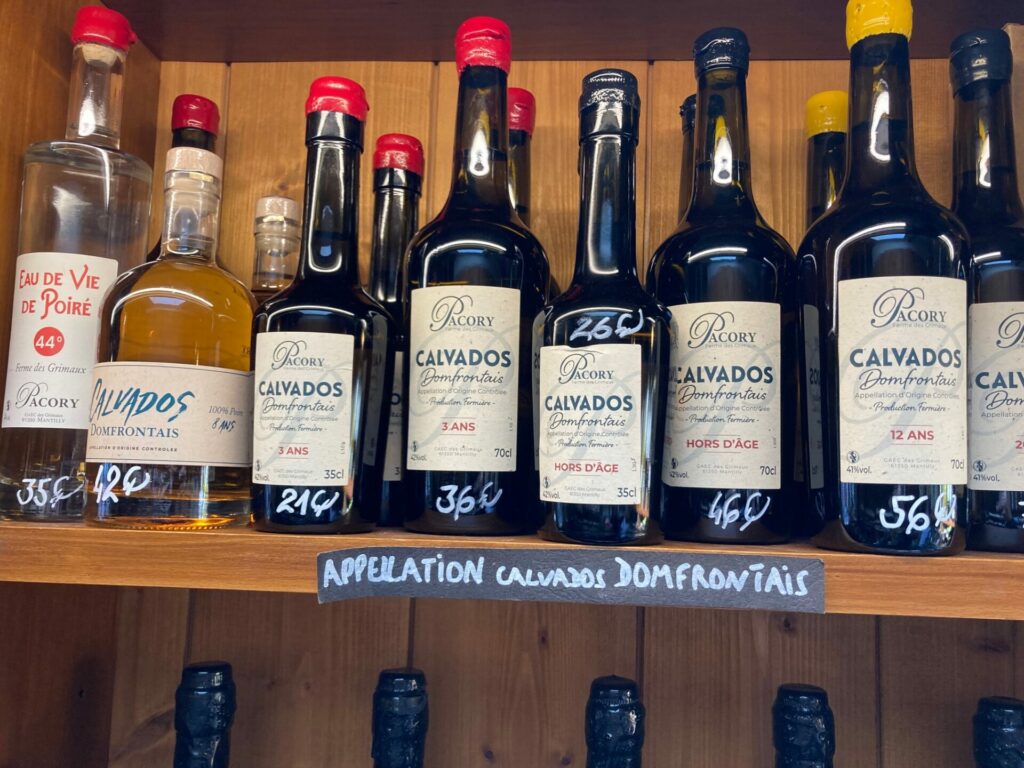
Where to eat, drink, and shop in Caen
La Casinière is a charming little bistro in the heart of the old quarter that offers delicious local French cuisine at unbeatable prices – a three-course menu at €32. I had the slow-cooked lamb shoulder and local French cheese assortment, and finished with a sublime house-made Valrhona chocolate cake with salted caramel and roasted peanuts.
Caen is the capital of the Calvados department of Normandy, making it a good gateway to the region famous for its cider and Calvados, a distilled cider also known as apple brandy. La Cidrologue, with floor to ceiling shelves of apple-based beverages, is a great place for an introduction to the regional specialty of French cider.
Where to stay in Caen
Les Chambres de l’Abbaye is a Chambre d’Hôtes (between a boutique hotel and a B&B), situated in an 18th century mansion, with rooms starting from €62. Parts of the charming Clos Saint-Martin boutique hotel date back to the 16th century, others to the 18th century, with rooms starting at €110.
Getting around in Caen
From the train/bus station it’s about a thirty-minute walk to the old quarter, or you can take a tram or taxi. If you stick to the old quarter and key sites listed above, it’s very walkable, or you can rent a Vélolib (city bike) at one of the town’s eleven bike stations.
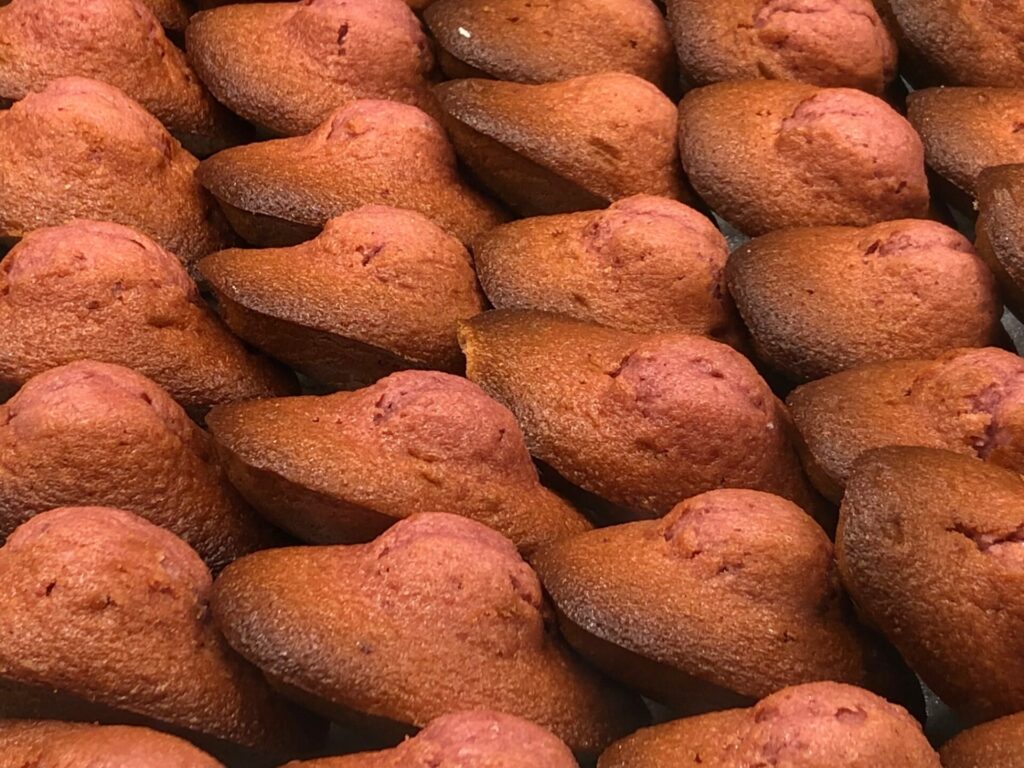
Cabourg
About two years ago, my cousin Sarah and her companion Maurice invited us to visit them in the Belle Époque beach town of Cabourg for a day trip from Paris. With its sizable beach, two and a half mile long beach-front promenade, Norman-style brick and half-timbered mansions, not to mention its old-fashioned main street and numerous restaurants, we experienced a coup de foudre (love at first sight). It’s been one of our top go-to getaways ever since. The spirit of Marcel Proust is everywhere in Cabourg, where he spent summers at the Grand Hôtel, and met many of the people who would find their way into his epic novel.
How to get to Cabourg
If you take the train from Paris to Caen, as we often do, the Nomad bus (line 111) takes you on a scenic 35-minute drive through villages and country roads to Cabourg (Hôtel de Ville is the closest stop to the center of town). From May through August there’s a train from Paris Gare Saint Lazare to Deauville, where a connecting 20-minute train ride takes you to Dives-sur-Mer (the station Proust arrived at), a neighboring village just fifteen-minute walk from Cabourg.
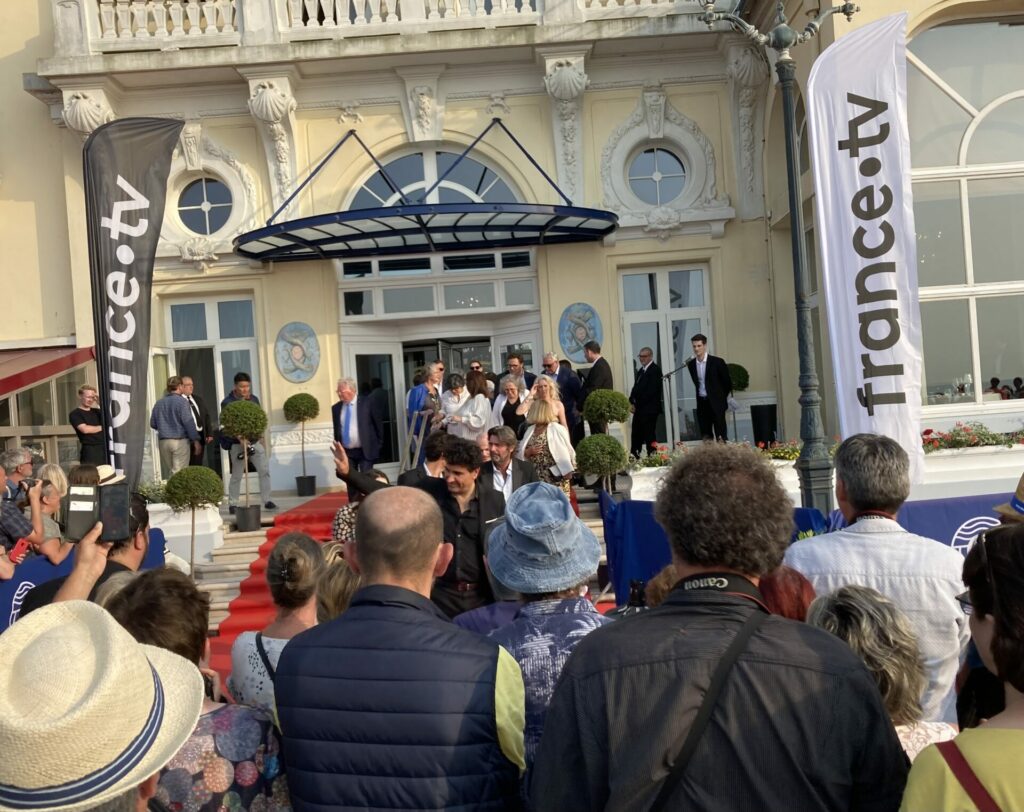
What to do and see in Cabourg
The Villa du Temps Retrouvé (“Villa of a past regained”) is a late-19th century mansion that has been transformed into a fun and informative museum/cultural center that evokes the period of Proust with installations, period memorabilia, art, film, furniture and events. There are also talks and arts-and-crafts activities for kids. The Villa has permanent installations, as well as a rotating annual theme, which is currently on the French silent movie star, Max Linder.
If you’re a movie buff, and love romance, you may want to take note that every year in mid-June Cabourg hosts the Festival du Film Romantique (the Romantic Film Festival), where actors and filmmakers from France and around the world present their movies and vie for the coveted Swann D’Or award. There are musical events throughout the season, such as Cabourg Mon Amour, a pop music festival on the beach in July.
With Normandy being horse country, a morning or evening horse ride on the beach (at €31 for an hour) is an obvious way to see the countryside. For the more adventurous, there are water and beach activities such as parasailing and sand yachting (basically dirt biking with a sailboat on wheels).
The beachfront miniature golf course with its whimsical diminutive world landmarks (Eiffel Tower, Big Ben, Pyramid of Giza, Statue of Liberty, etc.) also harks back to simpler pre-digital times of good family fun. The tourism office is a reliable source for culture and activities throughout the year.

Getting around in Cabourg (and environs)
We usually get to Cabourg by train and bus and get around exclusively on bike. There are two lovely neighboring villages that are well worth a visit. A twelve-minute bike ride just across the Dives river will get you to the village of Dives-Sur-Mer, where William set sail from in 1066 to conquer England. In Dives you’ll find his namesake Village d’Art Guillaume le Conquérant, a very photogenic and well-preserved Medieval village square-turned-shopping arcade. Down the street is the majestic 11th century Église Notre Dame de Dives-sur-Mer, where William and his commanders took Mass and were blessed before departing on their historic mission. If you’re lucky enough to be here on a Saturday, it’s worth checking out the market, held in an awesome 15th century wood and thatched roof halles (market place). I recommend renting at Dives Evasion. (Owner Christophe is extremely accommodating and personable.)
The village just three miles up the coast from Cabourg is Houlgate, a cozy Norman beach town with an impressive collection of brick and half-timbered Normandy style mansions. The vibe here is a bit more Hamptons French-style. It’s hillier than Cobourg, so an ebike might be best suited.
If you’ve come to Cabourg from Paris by train, or from Caen by bus, you may want to consider renting a car to explore some of the spots that are more challenging to reach by train or bus. There are two fairytale French villages within a half hour from Cabourg (an hour from Caen) worth visiting by car: Beuvron-en-Auge (whose charm enticed artist David Hockney to move here), and the multi-colored Beaumont-en-Auge. Vloc Liberte in Dives-Sur-Mer is a friendly family-owned agency where a car for the week is around €250 – the price of a two-day rental in Paris!
Our friends Michel and Francine, both Norman natives, took us on a glorious Normandy day trip from Cabourg (from Caen add a half hour) to discover some of the magical châteaux, cathedrals, and sites of the Calvados region of Normandy. The itinerary included: Manoir de Coupesarte, an original 15th-century wood framed Château on a moat; the stone and glazed brick castle of Satin-Germain de Livet; and the medieval Château de Crevecoeur (which has lots of activities and historical re-enactments for kids).
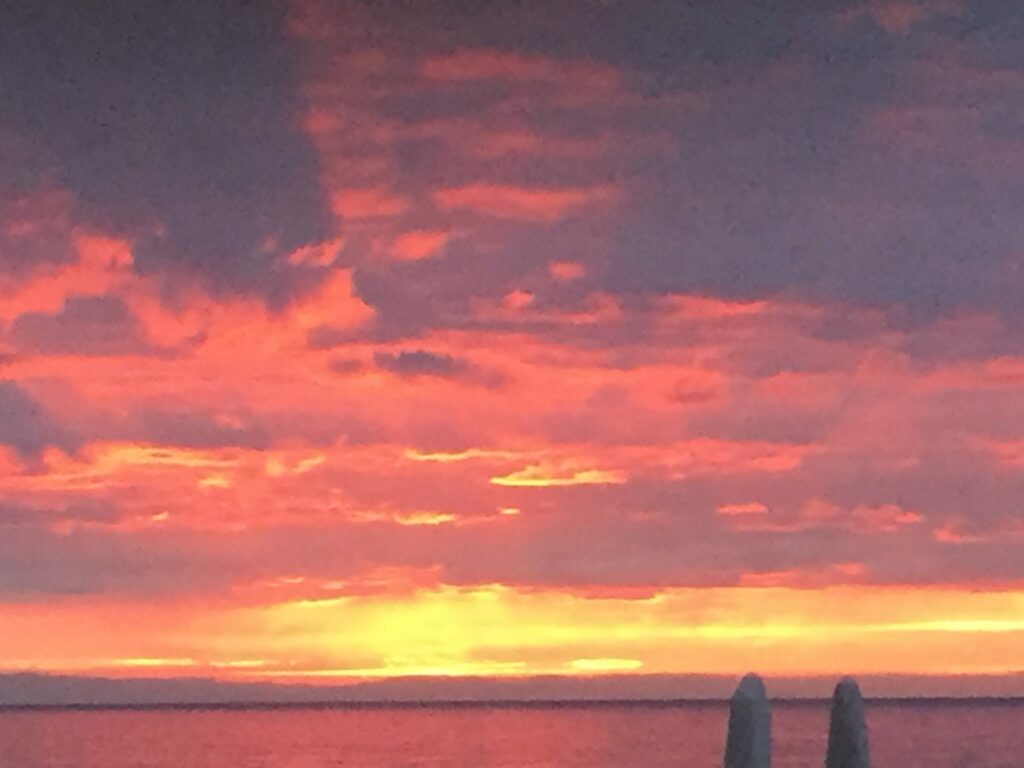
Where to eat, drink, and shop in Cabourg
Cabourg has some of the most spectacular French sunsets in the Normandy region, so seaside dining is highly recommended. To that end, on the Promenade Marcel Proust try Le Beau Site to watch the sunset as you eat, and Café de la Digue to enjoy local specialties like Moules-frites or Galettes (savory crepes) with a glass of local cider. A 14-minute bike ride from the center of town, you’ll find some of the most amazing, and most reasonably priced, innovative local ingredient-based French cuisine at Jeff Cuisine Sincère. For families with children, there’s an adorable and well stocked play area in the corner within sight where your kids can play while you enjoy your meal. After lunch, continue down the country road called Le Débarquement, which leads to a bike/foot path winding across fields, farms, and wooded trails. For shopping, À la Recherche du Temps Perdu offers a wide selection of Marinières – the traditionally blue and white striped sailor shirts that are a staple fashion accessory of the coast of France.
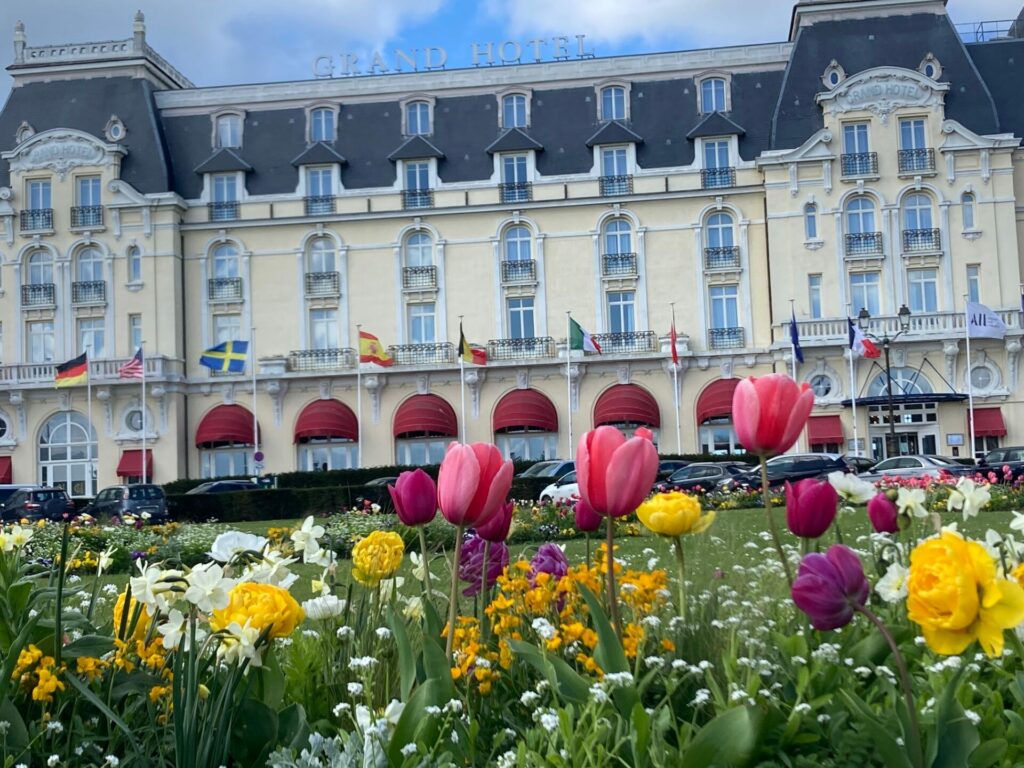
Where to stay in Cabourg
In town, and just two blocks from the bus stop Les Mots Passants, is a cozy no-frills hotel where double rooms range from about €76-110 per night. Rather than take the breakfast option, you may want to start your day at Dupont avec un Thé – the best bakery in town. You can get fresh-squeezed orange juice, coffee or tea, and a basket brimming with baked goods (including their famous Proust Madeleines) for €18.50. If you’re looking to splurge, then visit the Grand Hôtel of course, where rates can start from €260 to just over €400, depending on the season. (Hint: you can even ask for the Marcel Proust room, which has been kept in the style of his time.)

Honfleur
The 17th-century waterfront houses reflected along with the bobbing boats in the harbor are among the sites that make Honfleur such a popular destination in Normandy. Honfleur maintains its historic integrity in large part due to the fact that it was totally spared from bombings during the Allied landings.
Honfleur has a long connection to North America. Sixteenth century fishing boats frequently sailed to the New World to bring back salted cod, and in 1603 Samuel Champlain set off from here and founded Quebec. (There’s a commemorative statue and plaque on the harbor.)
How to get to Honfleur
You can take the A13 from Paris and get here in 2 hours and 20 minutes, or take the train from Gare Saint Lazare to Deauville, followed by a bus to Honfleur. If you begin your Normandy trip in Caen, you can take bus number 122 to Honfleur in an hour. Coming from Cabourg, as we did, the Nomad bus 111 gets you there in an hour and 15 minutes.
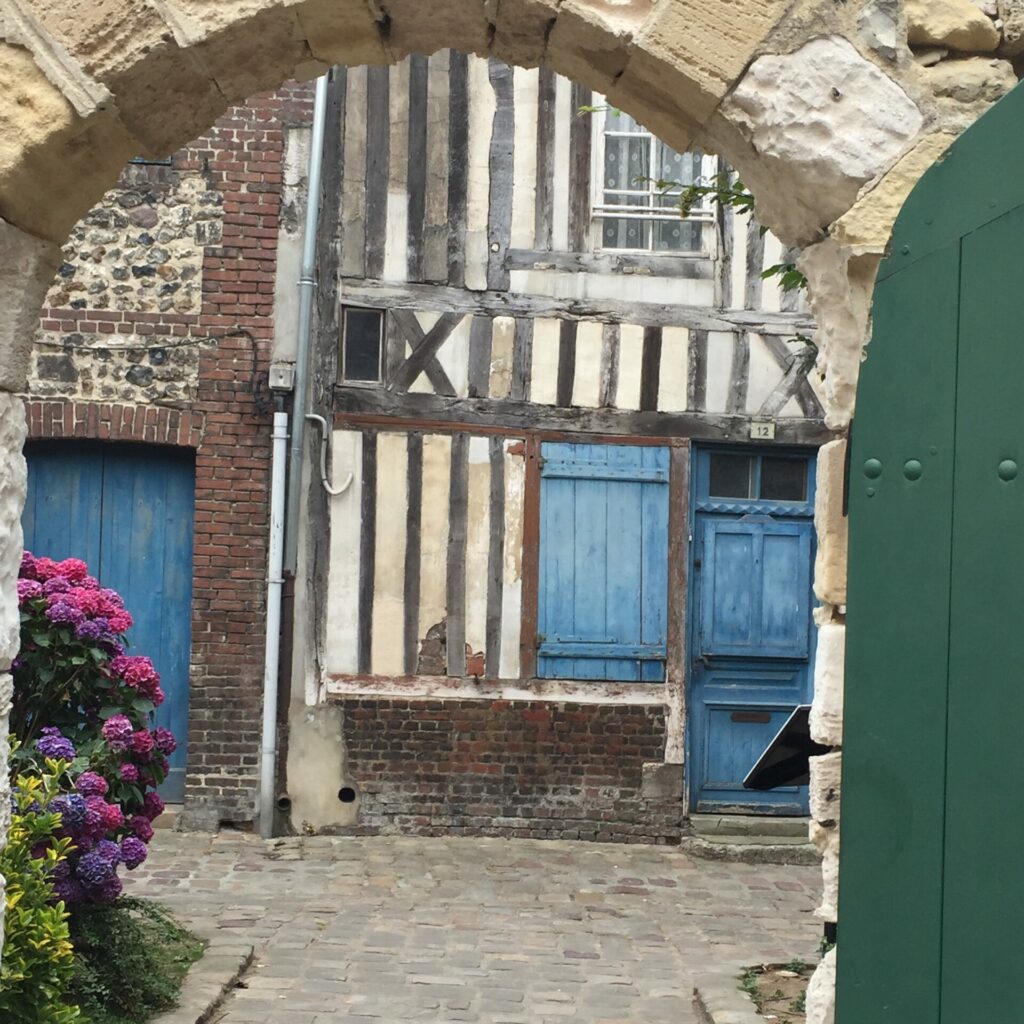
What to do and see in Honfleur
My sister-in-law Claudine (a part-time resident of Honfleur) took us on a wonderful tour to discover this enchanting 16th-century port town, with its multi-colored half-timbered houses, winding cobblestone streets, and hidden back alleys.
Built in the 15th century by shipbuilders, it’s no wonder the roof of Église Sainte Catherine – the largest wooden church in France – looks like the upside-down hull of a ship. What is a true wonder is that the timber structure has survived over six centuries. There are two museums in town worth visiting that feature local talents. Maison Satie is a museum offering interactive exhibits and memorabilia honoring native son Erik Satie, the monumentally influential early-20th century musician who collaborated with the likes of Picasso and Jean Cocteau. Musée de Honfleur showcases artists Eugéne Boudin, as well as his artist friends like Monet, Corot, and Courbet, among others.
Getting around Honfleur
The old city of Honfleur is totally doable by foot, but if you want to explore the environs a bit, Velhonfleur offers bike and ebike rentals, as well as guided tours.
Where to eat, drink, and shop in Honfleur
We took a break from our lovely stroll through Honfleur for superb cow-to-cone French ice cream at La Ferme Dubois Louvet, a scoop shop that’s owned by a local dairy farm. For the best local French restaurants, Claudine recommends L’Homme de Bois. With its open fireplace, brick walls, zinc bar, and candy-striped banquettes, this warm woody eatery serves up homestyle seafood dishes including lobster, fish soup, and oysters, and offers great value €29 and €39 prix fixe menus. She also pointed out to us the Bistro des Artistes, where Emmanuel and Brigitte Macron eat whenever in Honfleur.
Where to stay in Honfleur
L’Invitation au Voyage (invitation to travel) is an elegant 19-room boutique hotel near the harbor, with rooms ranging from €180-260 per night, depending on the day and season. Hôtel la Diligence is a lovely period stone-and-wood hotel in a quiet courtyard with rooms for €104 per night.
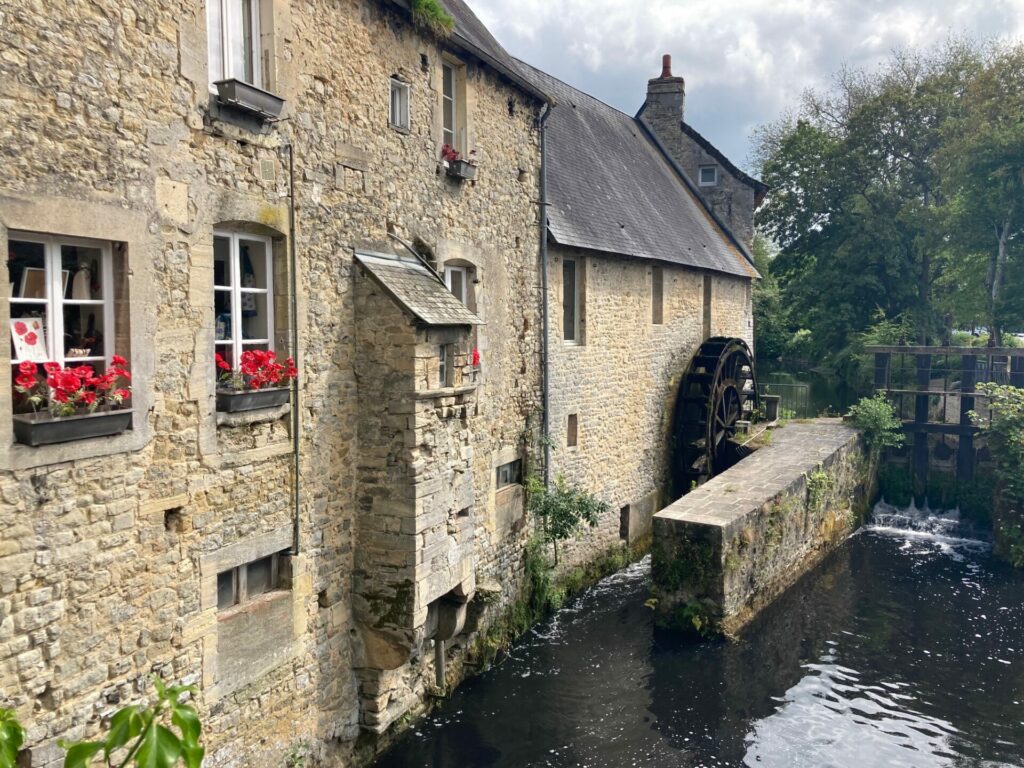
Bayeux
If its delightful medieval town and towering Norman gothic cathedrals weren’t enough, Bayeux is well worth a visit as the home of the magnificent Tapisserie de Bayeux (Bayeux Tapestry), the 230-foot-long elaborately embroidered tapestry that illustrates in 58 scenes the battles and rise to the throne of England in 1066 of William the Conqueror. The tapestry – which some call the very first French bande dessinée (graphic novel) – is housed in its own museum, which offers an audio guide in multiple languages.
The Cheese route
Cheese is often called the last dish, so French cheese lovers may want to finish a road trip through Normandy with a cheese tour (worth a trip from Paris to Normandy in its own right) of the three Normandy towns that have famous cheeses named after them: Livarot, Pont-Leveque, and Camembert. Best to do if you’re renting a car, however the train from Paris to Caen stops in Livarot and Pont-Leveque. Check out Auberge de la Touques for a memorable meal in Pont-Leveque.

Frequently Asked Questions – Paris to Normandy
How long is the train ride from Paris to Normandy?
The Normandy train from Paris takes about two hours.
Is there a high speed train from Paris to Normandy?
The main Normandy train line is called the Nomad, and runs through the SNCF, not the high speed train network known as the TGV.
Can you visit Normandy as a day trip from Paris?
Day trips from Paris to Normandy are common thanks to the region’s historical significance, but it will be a full day thanks to the added transportation time.
How far are the D-Day Normandy beaches from Paris?
The D-Day beaches in Normandy are about a 3-hour drive from Paris.
Philip Ruskin is an External Lecturer (ESSEC Bus. School), Consultant (food & travel marketing), writer, drummer and regular contributor to Frenchly. He loves to bike around his adopted hometown of Paris. Find him here, on Instagram. All photos by the author.

